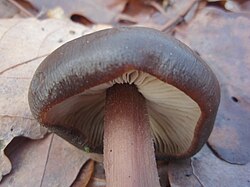| Rhodocollybia butyracea | |
|---|---|
 | |
| Scientific classification | |
| Kingdom: | Fungi |
| Division: | Basidiomycota |
| Class: | Agaricomycetes |
| Order: | Agaricales |
| Family: | Omphalotaceae |
| Genus: | Rhodocollybia |
| Species: | R. butyracea |
| Binomial name | |
| Rhodocollybia butyracea (Bull.: Fr.) Lennox [1] | |
| Synonyms | |
Collybia butyracea (Bull.: Fr.) Quélet | |
| Rhodocollybia butyracea | |
|---|---|
| Gills on hymenium | |
| Cap is convex or flat | |
| Hymenium is adnexed or free | |
| Stipe is bare | |
| Spore print is cream to buff | |
| Ecology is saprotrophic | |
| Edibility is edible | |
Rhodocollybia butyracea, commonly known as the buttery collybia, [2] [3] is a species of fungus in the family Omphalotaceae. It has a number of subspecies. [4]




